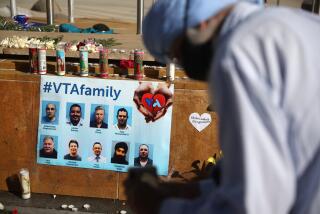Expert Says Job Stress Can Result in Violence
- Share via
While shooting one’s boss is a rare extreme, increased violence spawned by tensions in the workplace is “definitely a reality,” the director of the Oakland-based Institute for Labor and Mental Health said Monday.
“There is a growing danger of violence in the workplace as the level of stress increases,” said Michael Lerner, author of “Surplus Powerlessness,” a just-published book about the effects of stress on the job.
However, other labor experts doubt whether there is a correlation between increasing workplace tension and employee violence. Workplace stress has been an “occupational hazard since the beginning of time,” said Raymond Novaco, an associate professor of social ecology at UC Irvine.
There is no question that work pressures “can have an effect on personal adjustments and the health of the individual and the individual’s family,” he added. “But violence in the workplace is a rare event.”
Both Lerner and Novaco were unfamiliar with and could not comment on Monday’s murder-suicide at the Employment Development Department office in the Garden Grove. Authorities said an employee, Fidel Gonzalez Jr., 53, of Westminster, after a recent argument, shot and killed his superior, Louis H. Zuniga, and then turned the gun on himself.
It was not the first case of employee violence in Orange County. Last November, a chemical technician at a Tustin company allegedly stabbed two supervisors, one fatally, when they called the employee in to fire him.
The fired employee, Ivory Joe Valentine, 31, was arrested the following Monday morning when he apparently reported for work. A hearing to determine whether Valentine is mentally competent to stand trial is scheduled for today.
Lerner, in a telephone interview, said his research has shown that “if people are given no opportunity to express their anger at conditions that are oppressive, they express that anger in a random way--at their boss, at co-workers, at people on the street.”
The violence, while a byproduct of workplace tension, is not always restricted to the job site and the boss, he said. The tense feelings can be misdirected toward others, spilling over into a barroom brawl with a co-worker, family violence and even car accidents on the way home from the job, he said.
Based on his observations and those of about a dozen other therapists at his institute, Lerner has concluded that violence appears to be growing among those with white-collar, professional jobs. Public attitudes have fed those workers a “fantasy, an expectation of more fulfillment,” which clashes with the reality of “increasing workers (being) treated as though they are on an assembly line. . . . The conflict between expectations and reality can make it even more explosive.”
Lerner said he has seen nurses and social workers--two occupations where “there is an expectation of professional respect”--strike out at supervisors. Tensions in the growing electronics industry also have given rise to violent outbursts, he added.
However, UCI’s Novaco said that there is no data to compare the responses of white-collar violence against blue-collar outbursts. Since the public does not expect violence in the higher educated working class, incidents of workplace outbursts among professionals may receive more notice, he added.
Although the pressures of white-collar jobs can increase stress and lead to inappropriate outbursts, he said, they do not guarantee that workers will respond to on-the-job conflict with violence.
“Some people have always resorted to resolving conflict in violent ways,” he pointed out. But whether work frustrations were the cause of the violence is open to interpretation, he cautioned.
Looking toward solutions, Lerner said he has performed a study showing that violence diminishes when people have an opportunity to “express anger in a focused way.” He has tested employees who had been in organized “occupational stress groups” and compared their responses to employees with no outlet for their frustrations and anger.
The results showed that “the amount of random hostility expressed at inappropriate objects decreased dramatically” among those with “an opportunity for focused anger,” he said.
Lerner’s institute, which has done research on workplace stress through the National Institute of Mental Health, advises employers to “allow people a space in which they can express their anger at conditions that are oppressive.” Such occupational stress groups allow workers to get away from bosses, discuss common problems and then approach the employers as a group to talk about proposed changes, he suggested.
“We need to create forums to allow people to express anger and frustration more directly,” Lerner said. “What many need is a way of (expression) that is short of violence.”
More to Read
Sign up for Essential California
The most important California stories and recommendations in your inbox every morning.
You may occasionally receive promotional content from the Los Angeles Times.













